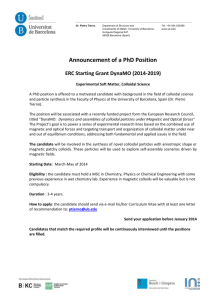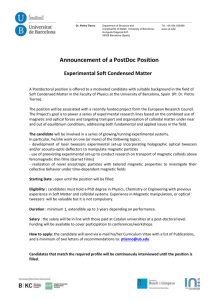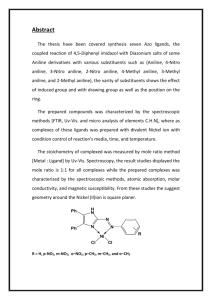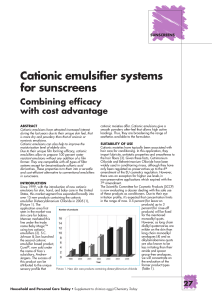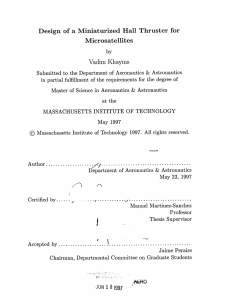Marking Scheme of Chemistry (PB-3) 2015-16
advertisement
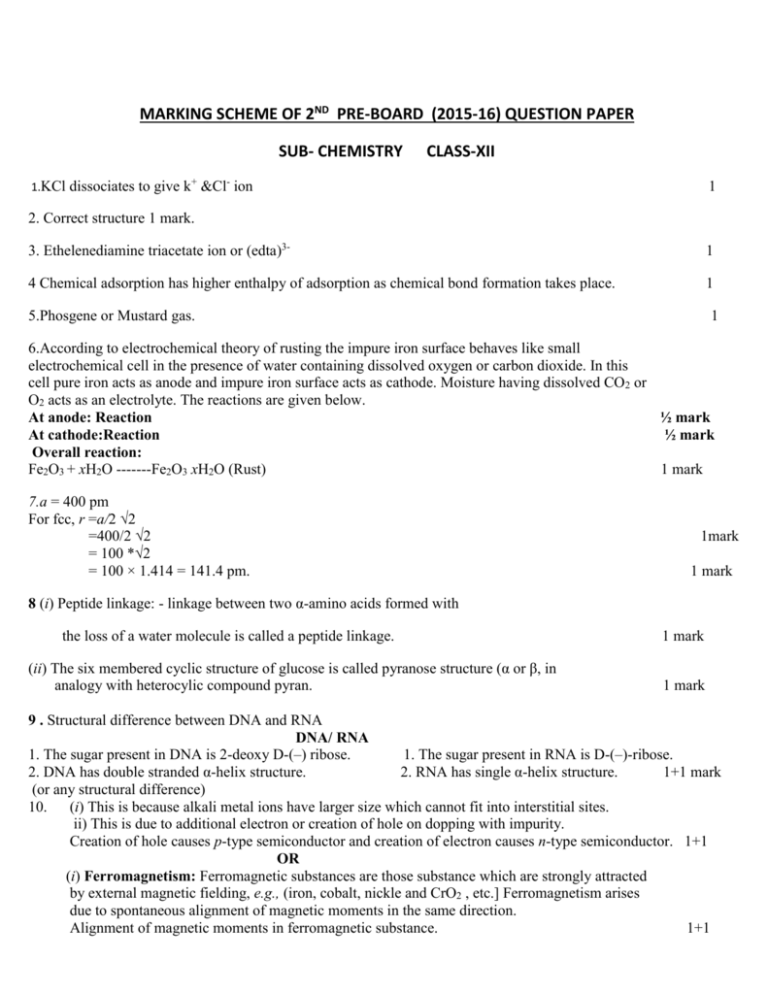
MARKING SCHEME OF 2ND PRE-BOARD (2015-16) QUESTION PAPER SUB- CHEMISTRY 1.KCl CLASS-XII dissociates to give k+ &Cl- ion 1 2. Correct structure 1 mark. 3. Ethelenediamine triacetate ion or (edta)3- 1 4 Chemical adsorption has higher enthalpy of adsorption as chemical bond formation takes place. 1 5.Phosgene or Mustard gas. 1 6.According to electrochemical theory of rusting the impure iron surface behaves like small electrochemical cell in the presence of water containing dissolved oxygen or carbon dioxide. In this cell pure iron acts as anode and impure iron surface acts as cathode. Moisture having dissolved CO2 or O2 acts as an electrolyte. The reactions are given below. At anode: Reaction ½ mark At cathode:Reaction ½ mark Overall reaction: Fe2O3 + xH2O -------Fe2O3 xH2O (Rust) 1 mark 7.a = 400 pm For fcc, r =a/2 √2 =400/2 √2 = 100 *√2 = 100 × 1.414 = 141.4 pm. 1mark 1 mark 8 (i) Peptide linkage: - linkage between two α-amino acids formed with the loss of a water molecule is called a peptide linkage. (ii) The six membered cyclic structure of glucose is called pyranose structure (α or β, in analogy with heterocylic compound pyran. 1 mark 1 mark 9 . Structural difference between DNA and RNA DNA/ RNA 1. The sugar present in DNA is 2-deoxy D-(–) ribose. 1. The sugar present in RNA is D-(–)-ribose. 2. DNA has double stranded α-helix structure. 2. RNA has single α-helix structure. 1+1 mark (or any structural difference) 10. (i) This is because alkali metal ions have larger size which cannot fit into interstitial sites. ii) This is due to additional electron or creation of hole on dopping with impurity. Creation of hole causes p-type semiconductor and creation of electron causes n-type semiconductor. 1+1 OR (i) Ferromagnetism: Ferromagnetic substances are those substance which are strongly attracted by external magnetic fielding, e.g., (iron, cobalt, nickle and CrO2 , etc.] Ferromagnetism arises due to spontaneous alignment of magnetic moments in the same direction. Alignment of magnetic moments in ferromagnetic substance. 1+1 (ii) Ferrimagnetism: Ferrimagnetism is observed when the magnetic moments of the domains in the substance are aligned in parallel and antiparallel directions in unequal number resulting in some net magnetic moment, e.g., Fe3O4 (magnetite) and ferrites like MgFe2O4 11 .(i) The movement of colloidal particles towards oppositely charged electrodes in an electric field is called electrophoresis. (ii) There are some substances such as soap which at low concentration behave as normal electrolytes, but at higher concentration exhibit colloidal behaviour due to the formation of aggregates. The aggregated particles thus formed are known as micelles or associated colloids. (iii) The process of converting a procipitate into colloidal solution by shaking it with dispersion medium in the presence of small amount of electrolyte is called peptization. 12Characteristics Lanthanoids Actinoids (i) Electronic configuration [Xe] 4f 1-145d0-16s2 [Rn] 5f 1-14 6d0-17s2 (ii) Oxidation states Besides + 3 O.S. lanthanoids show +2 and +3 O.S. only in a few cases. Besides +3 O.S. actinoids show higher O.S. of +4, +5, +6, +7 also because of smaller energy gap between 5f , 6d and 7ssubshell. (iii) General chemical reactivity of elements These are less reactive metals These are highly reactive metals. Lesser tendency towards complex formation. Greater tendency towards complex format Do not form oxocation Form oxocation Compounds are less basic. Compounds are more basic. 13. Monomer name and structure 3(1/2 +1/2 ) (i) Nylon-6 Caprolactum ii) Teflon Tetrafluoro ethene (iii) Neoprene Chloroprene 14 (a) Lead storage battery is a secondary battery. The reactions occurring in lead storage battery when current is drawn from it are: Anode: Pb(s) + SO42–(aq) PbSO4(s) + 2e– Cathode: PbO2(s) + SO42–(aq) + 4H+(aq) + 2e– PbSO4(s) + 2H2O(l) Overall reaction: Pb(s) + PbO2(s) + 2H2SO4(aq) 2PbSO4(s) + 2H 2O(l) OR 2+ – At Anode: Cu Cu + 2e At Cathode: Ag+ + e Ag Cell reaction: Cu + 2Ag+Cu2+ + 2Ag Ecello = 0.46 V; [Ag+] = 1 × 10–3 M, [Cu2+] = 0.1M : n = 2 Substituting the values in the equation: Ecell = Ecello –0.059/2*log[Cu 2+ ]/[Ag+ ] 2 we get = 0.46 V – (0.0295 log 105) = 0.46V – 0.0295 × 5 = 0.3125 V 15.i) In aniline due to resonance the lone pair of electrons on the nitrogen atom are delocalized over the benzene ring. As a result, the electron density on the nitrogen decreases. On the other hand, in methyl amine +I effect of CH3 increases the electron density on the nitrogen atom. Therefore 1+1+1 1+1+1 1 1 1 1 1 1 aniline is a weaker base than methyl amine and hence its pKb value is higher than that of methyl amine. (ii)Due to alkaline nature of solution of methylamine precipitation of Fe(OH)3 occurs. (iii) Aniline being a Lewis base, reacts with lewis acid AlCl3 to form a salt. Due to this N atom of aniline acquires positive charge and hence acts as a strong deactivation group for further reaction. (1+1+1) 16. (i) The principle of froth floatation process is that sulphide ore particle are preferentially wetted by pine oil, whereas the gangue particles are wetted by water. (ii) Zone refining is based on the principle that the impurities are more soluble in (liquid state) than in the solid state of the metal. (iii) The principle of refining by liquation is that the impurities whose melting points are higher than the metal are left behind on melting the impure metal. Hence pure metal separates out. .1+1+1 17.(i) Cationic Detergents : Cationic detergents are quarternary ammonium salts of amines with acetates, chlorides or bromides as anions. Cationic part possess a long hydrocarbon chain and a positive charge on nitrogen atom. Hence, these are called cationic detergents. Cetyltrimethylammonium bromide is a popular cationic detergent and is used in hair conditioners. Cationic detergents have germicidal properties and are expensive, therefore, these are of limited use. (ii) Food Preservatives: These are the chemical substances which are added to the food materials to prevent their spoilage due to microbial growth and to retain their nutritive value for long periods.The most-common preservations used are, sugar table salt, sodium benzoate, Sodium metabisulphite sorbic acid and propanoic acid. (iii) Analgesics: Drugs which reduce or abolish pain without causing impairment of consciousness, mental confusion, incoordination or paralysis or some other disturbances of nervous system. These are classified as follow. (a) Non-narcotic (non-addictive) analgesics: Aspirin, paracetamol etc. (b) Narcotic drugs: These are known to be habit forming, e.g., morphine, Codeine, Heroin etc.Preservatives prevent the rancidity of food and inhibit growth or kill the microganisms. 1+1+1 18. (i) Increasing order of basic strength is: C6H5NH2 < C6H5N(CH3)2 < CH3NH2 < (C2H5)2NH (ii) p-Toluidine > Aniline > tr-nitroaniline (iii) (C2H5)2 NH2 < C2H5NH2 < C6H5NHCH3 < C6H5NH2 1+1+1 19. Compound A=Na2CrO4 & Compound B =Na2Cr2O7. 1 Reaction =2 marks 20.i) one use each b) [Ni(CN) ]2-4 1 mark Structure: Square planar. Magnetic behaviour: Diamagnetic due to the absence of unpaired electrons 1 (Low spin complex) Ni(CO)4 Structure: Tetrahedral Magnetic behaviour: Diamagnetic due to the absence of unpaired electrons. (Low spin complex) 21.a)Each name reaction 1 +1mark b) hydroboration or any suitable reaction in not more than two steps 22.i)Proper mechanism with steps 2 1 ii) p-Bromophenol 23.Ans.a) values 1 1 b) proper reason 1 c) statement expression and graph 24.a) 1+1/2 + 1/2 Each preparation one mark b) i) Ethanal will give Iodoform test + reaction ii) Acetophenone will give Iodoform test +reaction iii) Phenol will give FeCl3 test + reaction. OR a) Suitable test 1+1 b) Each conversion one mark. 1+1 1 1 1 1+1+1 25.a Each structure (b) proper reason 1 1+1+1 OR (a)) Each structure 1 mark. b) proper reason 1+1+1 26 (a) (i) Rate of Reaction: It is defined as the decrease in the concentration of reactants per unit time or increase in the concentration of products per unit time. For a hypothetical reaction RP 1 (ii) Activation energy: The amount of energy which the reactants must absorb to pass over the energy barrier between reactants and products is known as the activation energy . 1 (b) Only first part (formulae + putting correct values + calculation &correct answer )1+1+1 . OR (a) (i) The order of a reaction can be defined as the sum of the powers of the concentration terms as expressed in rate law. (ii) Molecularity: It may be defined as the number of reacting species (molecules, atoms or ions) taking part in an elementary reaction, which must collide simultaneously in order to bring about a chemical reaction. (b) (i) Given T1 = 300 K T2 = 320 K R = 8.134 JK–1 mol–1 Ea = ? Substituting the values and solving Ea=55.32 kJ mol–1. 1+1+3


